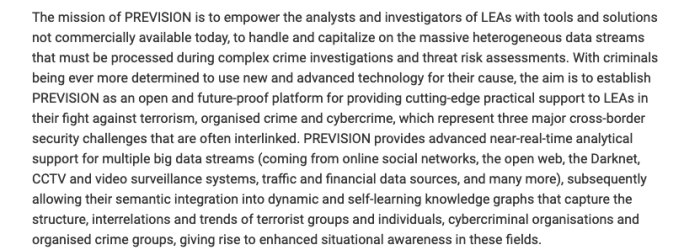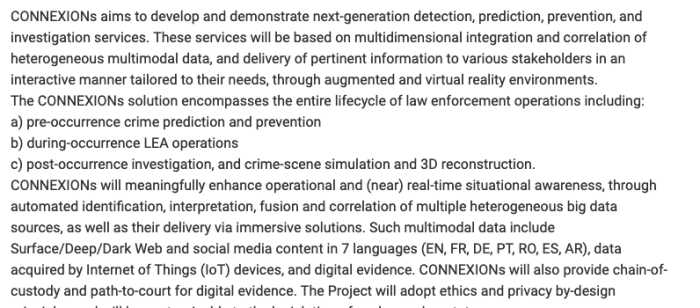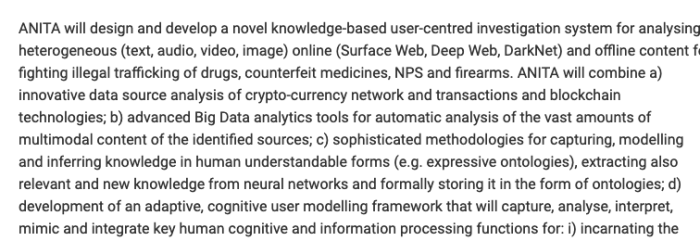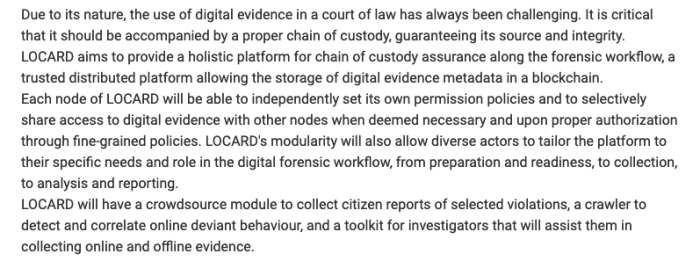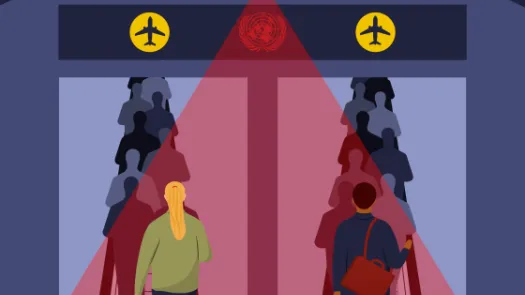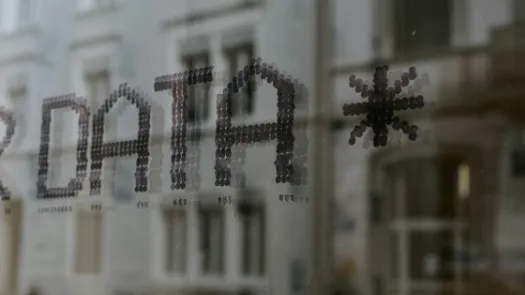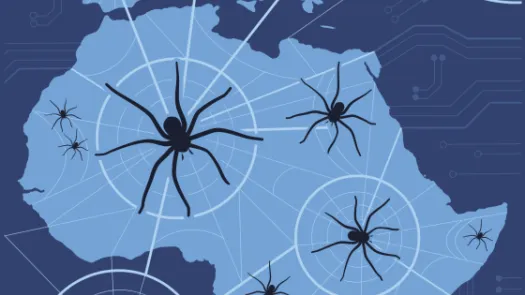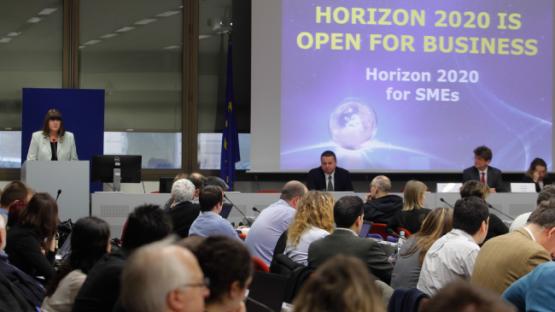
MONITORYOU: the MilliONs beIng spenT by the eu on develOping surveillance tech to taRget YOU
The EU gives millions to surveillance companies, universities, and government agencies to develop cutting-edge surveillance technologies.
- The EU spends millions on research aimed at developing surveillance tech
- Here are some of the most concerning ongoing projects, as of January 2020
- They provide an insight into the future of surveillance
- Not only are the projects highly invasive, they divert precious research funds away from other vital areas that could actually make our lives better.

The European Union (EU) spends billions on research and development aimed at driving economic growth and jobs, as well as furthering the bloc’s broader agenda. Within the current budget, known as Horizon 2020 and covering the years 2014-2020, some €80 billion has been made available for research in a huge number of areas, ranging from finding cures for diseases to helping keep the earth viable for life.
From the same budget, it also funds a lot of projects aimed at developing surveillance technology. Successive research budgets have ploughed billions in euros to surveillance companies, government security agencies, and universities to conduct research and develop products to complement EU and national internal security policies.
Much of the funding goes to companies which sell surveillance tech to governments or to government agencies which themselves carry out surveillance. This not only furthers surveillance capabilities; it takes money away from other vital research.
Privacy International has argued that some of the types of surveillance being supported, such as facial recognition and mass surveillance fundamentally violate international human rights laws. Others, such as the forensic extraction of data from devices, must only be conducted within a highly regulated framework, which many jurisdictions lack. It is unclear how some of the funded projects being supported – such as those aimed at monitoring potential migrants to Europe – comply with EU rules, including on data protection.
This is a matter of concern as much of this technology may soon be trialled or eventually commercialised and sold on the open market - ironically at the same time as European Parliamentarians are pushing to reign in the European surveillance trade. As the current research budget is set to expire, it will soon be replaced by a new round, which is expected to further boost spending on security and military research.
Below is a list of some of these research projects which are ongoing as of January 2020.
__________________
Name: Prediction and Visual Intelligence for Security Information (PREVISION)
EU Contribution: €8m (2019-2021)
Description: A predictive platform running analytics through data obtained from "online social networks, the open web, the Darknet, CCTV and video surveillance systems, traffic and financial data sources, and many more"
Description From Project Page:
___
Name: Prediction and Visual Intelligence for Security Information (ROXANNE)
EU Contribution: €7m (2019-2022)
Description: Project aimed at identifying people in intercepted communications using face & speech identification, soon to be trialled in 9 countries
Description From Project Page:
__________________
Name: Fighting Crime and TerroRism with an IoT-enabled Autonomous Platform based on an Ecosystem of Advanced IntelligEnce, Operations, and InveStigation Technologies (CREST)
EU Contribution: €7m (2019-2022)
Description: A predictive analytics platform monitoring online content and data from "Internet of Things" (IoT) devices, and for sharing "digital evidence based on blockchain" technology§
Description From Project Page:
__________________
Name: InterCONnected NEXt-Generation Immersive IoT Platform of Crime and Terrorism DetectiON, PredictiON, InvestigatiON, and PreventiON Services (CONNEXION)
EU Contribution: €5m (2018-2021)
Description: a predictive policing tool relying on social media, 'dark web', and IoT data
Description From Project Page:
__________________
Name: Migration-Related Risks caused by misconceptions of Opportunities and Requirement (MIRROR)
EU Contribution: €5.1m (2019-2022)
Description: to monitor social and other media to find "misperceptions and targeted misinformation campaigns" among people possibly looking to migrate to Europe, and to make sure border agencies counteract "media manipulation"
Description From Project Page:
__________________
Name: Understand the Impact of Novel Technologies, Social Media, and Perceptions in Countries Abroad on Migration Flows and the Security of the EU & Provide Validated Counter Approaches, Tools and Practices (PERCEPTIONS)
EU Contribution: €4.9m (2019-2022)
Description: Monitoring social media to identify perceptions influencing migration to Europe which "might also even lead to security threats, risks or radicalisation."
Description From Project Page:
__________________
Name: From mobile phones to court – A complete FORensic investigation chain targeting MOBILE devices (FORMOBILE)
EU Contribution: €6.9m (2019-2022)
Description: Another mobile phone extraction system, which will also develop "tools" for "the acquisition of previously unavailable mobile data, unlocking mobile devices, as well as the decoding and analysis of mobile data"
Description From Project Page:
__________________
Name: Autonomous swarm of heterogeneous RObots for BORDER surveillance (ROBORDER)
EU Contribution: €8m (2017-2021)
Description: Development of unmanned robots (air, land, sea and underwater) to monitor borders
Description From Project Page:
__________________
Name: Multimedia Analysis and Correlation Engine for Organised Crime Prevention and Investigation (MAGNETO)
EU Contribution: €5.3 (2018-2021)
Description: Data analytics platform to conduct tasks like relationship mapping in large datasets and predicting threats
Description From Project Page:
__________________
Name: Advanced tools for fighting oNline Illegal TrAfficking (ANITA)
EU Contribution: 4.9m (2018-2021)
Description: Data analytics programme monitoring data from the internet and crypto-currencies
Description From Project Page:
__________________
Name: Intelligence Network and Secure Platform for Evidence Correlation and Transfer (INSPECTr)
EU Contribution: €6.9m (2019-2022)
Description: Another analytics platform for "gathering, analysing, prioritising and presenting key data to help in the prediction, detection and management of crime"
Description From Project Page:
__________________
Name: Novel Social Data Mining Platform to Detect and Defeat Violent Online Radicalization (INSIKT)
EU Contribution: €1.5m (2017-2020)
Description: Software developed by a Spanish companies which scrapes through social media to identify terrorist propaganda
Description From Project Page:
__________________
Name: Lawful evidence collecting and continuity platform development (LOCARD)
EU Contribution: €6.8m (2019-2022)
Description: A forensics system to extract data from devices for use in court, which also includes "a crawler to detect and correlate online deviant behaviour"
Description From Project Page:
__________________
Name: Video analysis for Investigation of Criminal and TerrORIst Activities (VICTORIA)
EU Contribution: €5m (2017-2020)
Description: An automatic surveillance video analysis system
Description From Project Page:
__________________
Name: Analysis System for Gathered Raw Data (ASGARD)
EU Contribution: €12m (2016-2020)
Description: This project will develop, maintain and evolve a tool set for the extraction, fusion, exchange and analysis of Big Data, including cyber-offense data for forensic investigation
Description From Project Page:
__________________
The descriptions of these projects may make the research funded appear innocuous and simply contributing in extending the work police and intelligence agencies are already doing. However, there are serious concerns with regard to these projects, including but not limited to the degree of invasiveness to our privacy, the lack of an appropriate framework or protections both for conducting this research as well as for the deployment of the tools and the lack of safeguards. It is alarming that the EU is spending all this money securitising research at the expense of other vital areas that could actually make our lives better.
There have been consistent calls by Parliamentarians, civil society, and academics to reform the programme, by for example excluding companies and authorities complicit in human rights abuses, such as Israeli arms companies. While the result has been the development of ethical approval process, as Statewatch argues, it does not "overcome the political environment and objectives in which it is framed", which sees the development of surveillance and security capabilities as the goal in itself, rather than something which can be avoided.
More Resources:
- Statewatch Observatoryon the European security-industrial complex
-
Privacy International Campaign: Challenging the Drivers of Surveillance
Photo: European Union, 2014
